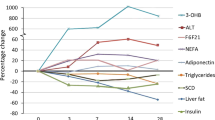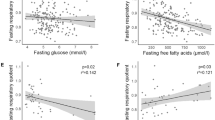Abstract
BACKGROUND: Fatty acid oxidation has frequently been measured using 13C or 14C labeled fatty acids. While providing valuable data, the breath test method is hindered by the need for a controlled environment to measure VCO2 and collect frequent breath samples. Additionally, the CO2 breath tests require the use of 13C- or 14C-acetate to correct for isotope exchange in the TCA cycle. We validated d31-palmitic acid for measuring dietary fat oxidation. When oxidized, the deuterium appears as water and mixes with the body water pool providing a cumulative record of fat oxidation.
METHODS: The recovery of deuterium from d31-palmitic acid at 10 h post-dose was compared to that of 13CO2 from [1-13C]-palmitic acid in nine subjects (body mass index (BMI) = 23.6±2.8; percentage body fat (%BF) = 22.6±5.3; mean±s.d.). Subjects were studied at rest. [1-13C]-acetate (2 mg/kg) was dosed in a liquid breakfast. On a second day, [1-13C]-palmitic acid (10 mg/kg) and d31-palmitic acid (15 mg/kg) were dosed with the same liquid breakfast.
RESULTS: Recovery of 13CO2 from [1-13C]-acetate at 10 h post-dose was 53.7±10.4%. Recovery of d31-palmitic acid was 13.2±7.7% (mean±s.d.) and [1-13C]-palmitic acid recovery was 6.4±3.6%. When the 13C data was corrected for [1-13C]-acetate (Na salt) recovery, the mean difference in percentage recovery between the two tracers was 0.5±2.8% and cumulative recoveries through 10 h post-dose were highly correlated (y = 1.045x−0.47; r2 = 0.88, P<0.0002). Our data shows both labels to be equivalent in their ability to measure dietary fat oxidation in resting subjects.
CONCLUSIONS: The use of deuterium labeled palmitic acid eliminates the need for rigid control over the subjects' environment. Frequent sampling and measurement of VCO2 are not needed for accurate calculation of percentage recovery of the deuterium label. In addition, the deuterium label has a decreased potential for isotopic exchange compared to 13C or 14C, so a recovery correction factor is probably not required.
This is a preview of subscription content, access via your institution
Access options
Subscribe to this journal
Receive 12 print issues and online access
$259.00 per year
only $21.58 per issue
Buy this article
- Purchase on Springer Link
- Instant access to full article PDF
Prices may be subject to local taxes which are calculated during checkout




Similar content being viewed by others

Notes
Del per mille (δ) = (RU/RSTD−1)1000.
References
Bessesen D, Rupp C, Eckel R . Trafficking of dietary fat in lean rats Obes Res 1995 3: 191–203.
Klein S, Wolfe R . The use of isotopic tracers in studying lipid metabolism in human subjects Baillière's Clin Endocrinol Metab 1987 1: 797–816.
Schoeller D, Schneider J, Solomons N, Watkins J, Klein P . Clinical diagnosis using stable isotope 13C in CO2 breath tests: methodology and fundamental considerations J Lab Clin Med 1977 90: 412–421.
Jones P, Pencharz P, Clandinin M . Whole body oxidation of dietary fatty acids: implications for energy utilization Am J Clin Nutr 1985 42: 769–777.
Sidossis L, Coggan A, Gastaldelli A, Wolfe R . Pathway of free fatty acid oxidation in human subjects: implications for tracer studies J Clin Invest 1995 95: 278–284.
Sidossis L, Coggan A, Gastaldelli A, Wolfe R . A new correction factor for use in tracer estimations of plasma fatty acid oxidation Am J Physiol 1995 269: E649–E656.
Schrauwen P, Aggel-Leijssen Dv, Lichtenbelt WvM, Baak Mv, Gijsen A, Wagenmakers A . Validation of the [1,2-13C]acetate recovery factor for correction of [U-13C]palmitate oxidation rate in humans J Physiol 1998 513: 215–223.
Schrauwen P, Blaak E, Aggel-Leijssen Dv, Borghouts L, Wagenmakers A . Determinants of the acetate recovery factor: implications for estimation of [13C]substrate oxidation Clin Sci 2000 98: 587–592.
Romanski S, Nelson R, Jensen M . Meal fatty acid uptake in human adipose tissue: technical and experimental design issues Am J Physiol 2000 279: E447–E454.
Romanski S, Nelson R, Jensen M . Meal fatty acid uptake in adipose tissue: gender effects in nonobese humans Am J Physiol 2000 279: E455–E462.
Schoeller D, van Santen E . Measurement of energy expenditure in humans by doubly labeled water method J Appl Physiol 1982 53: 955–959.
FAO/WHO/UNU . Energy and protein requirements Report of a Joint Expert Consultation. Geneva: WHO 1985.
Schoeller D, Luke A . Rapid 18O analysis of CO2 samples by continuous-flow isotope ratio mass spectrometry J Mass Spectrom 1997 32: 1332–1336.
Bland J, Altman D . Statistical methods for assessing agreement between two methods of clinical measurement Lancet 1986 Feb 8 307–310.
Gass G, Kaplan H (eds) . Handbook of endocrinology 2nd edn. CRC Press: Boca Raton, FL 1996.
Shils M, Olson J, Shike M (eds) . Modern nutrition in health and disease 8th edn. Philadelphia, PA: Lea & Febiger 1994.
Acknowledgements
We would like to thank our volunteers for their time and patience while participating in the study. Additionally, we thank Dr Stephane Blanc for his suggestions on the manuscript.
Author information
Authors and Affiliations
Corresponding author
Rights and permissions
About this article
Cite this article
Votruba, S., Zeddun, S. & Schoeller, D. Validation of deuterium labeled fatty acids for the measurement of dietary fat oxidation: a method for measuring fat-oxidation in free-living subjects. Int J Obes 25, 1240–1245 (2001). https://doi.org/10.1038/sj.ijo.0801672
Received:
Revised:
Accepted:
Published:
Issue Date:
DOI: https://doi.org/10.1038/sj.ijo.0801672
Keywords
This article is cited by
-
Exercise training improves fat metabolism independent of total energy expenditure in sedentary overweight men, but does not restore lean metabolic phenotype
International Journal of Obesity (2017)
-
Getting the label in: practical research strategies for tracing dietary fat
International Journal of Obesity Supplements (2012)
-
The Short‐Term Effect of Diacylglycerol Oil Consumption on Total and Dietary Fat Utilization in Overweight Women
Obesity (2011)
-
Retention, Fixation, and Loss of the [13C] Label: A Review for the Understanding of Gastric Emptying Breath Tests
Digestive Diseases and Sciences (2008)
-
Methodology for studying postprandial lipid metabolism
European Journal of Clinical Nutrition (2007)


